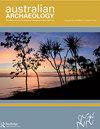Revolution or reform?
IF 1.2
3区 历史学
Q2 ANTHROPOLOGY
引用次数: 0
Abstract
It is hard to disagree with much of this Forum’s argument. Belief in ‘progress’, notably measured by material well-being and based on intensive agriculture, is indeed at the heart of many present-day worldviews, at least in Western societies. And while this is likely to be evolutionarily unsound in the long-term, few of us actively move into different lifestyles to give up much of what we get from it. Dark Emu, as many have pointed put, has bought right into the belief that materiality is the way to define progress. Has Australian archaeology done the same? Yes and no. Dark Emu’s public success is very clearly because it portrays Aboriginal people in the way many white Australians would like them to be. At a time – in the last decade – when there has finally been a stronger move to recognise Aboriginality as an important part of our society, portrayal of Aboriginal people as agriculturalists, curators and manipulators of the Australian environment, which is now becoming harder for us to manage, was almost bound to be acceptable. Had Pascoe written accurately about the nuanced variations with which different societies managed their local environments in different parts of Australia, he would undoubtedly have had much less recognition. That is what has befallen the various attempts by archaeologists, anthropologists and geographers (e.g. Gammage 2011; White 2011) to do just this. So at one level I count Dark Emu a success, in that it has encouraged recognition of Aboriginal perspicacity and adaptiveness. It is ‘a tragedy’ only from one perspective. What about Australian archaeology? The paper says that ‘innovative resource managers’, ‘efficient adaptive strategies’ and ‘searching for new resources’ is the ‘language of Western modernity’, based on the bedrock idea of material progress. But another way of looking at it is to think of these interpretations using the philosophy and language of modern evolutionary biology, which is not ‘progressive’ at all. Approaches using modern evolutionary theory help explain, in fact, just how the long-term inhabitants of this continent succeeded in continuing to live here, using techniques which we now strive to understand. And indeed, the only example cited is the integration of Aboriginal burning practices with current Euro-Australian fire management, which I see as a prime example of the adaptation of techniques derived from both cultures. What such analyses do not readily encompass, it is true, are aspects of life’s ‘social and spiritual dimensions’ that the Forum’s authors seek to include. These dimensions, I would argue, are not actually ‘left out’ of modern archaeology: they are included in other analyses, notably rock art. And they are, as is usually recognised, much harder to elucidate from the archaeological record, however readily they may be offered to us by Aboriginal research partners. It is interesting and probably significant that nothing of the kind the authors would like us to experience and develop are cited here. What should archaeologists actually be doing that will positively improve the current situation? Saying everything we do is wrong is easier than working out how to set matters right. I do not want to say that our current ways of working with Aboriginal communities are perfect. As we all know, two-way learning is a constant process of adaptation and adjustment, usually leavened, as the authors realise, by goodwill as well as misunderstandings on both sides. Thus I will not agree with the authors, hold up my hands in horror and say present-day Australian archaeological practice is ‘a tragedy’. Like the rest of life, there are good and bad bits. We may need reform, we do need to keep paying careful attention to what our Aboriginal partners want and share leadership with革命还是改革?
很难不同意本论坛的许多论点。相信“进步”,尤其是以物质福利和集约农业为基础的进步,确实是当今许多世界观的核心,至少在西方社会是如此。虽然从长远来看,这在进化上可能是不健全的,但我们中很少有人会主动进入不同的生活方式,放弃我们从中获得的大部分东西。正如许多人所指出的那样,深色Emu已经相信物质性是定义进步的方式。澳大利亚的考古学也这么做了吗?是和否。Dark Emu的公开成功非常明显,因为它以许多澳大利亚白人希望的方式描绘了原住民。在过去的十年里,当人们终于采取了更有力的行动,承认原住民是我们社会的重要组成部分时,将原住民描绘成了农学家,澳大利亚环境的管理者和操纵者,现在对我们来说越来越难管理,几乎肯定是可以接受的。如果帕斯科准确地写下了澳大利亚不同地区不同社会管理当地环境的细微变化,他无疑会得到更少的认可。这就是考古学家、人类学家和地理学家(例如,Gammage 2011;White 2011)为实现这一目标而进行的各种尝试的结果。因此,在某种程度上,我认为深色Emu是一种成功,因为它鼓励了人们对原住民洞察力和适应性的认可。仅仅从一个角度来看,这是一场“悲剧”。澳大利亚考古怎么样?该论文称,“创新的资源管理者”、“高效的适应性战略”和“寻找新资源”是“西方现代性的语言”,基于物质进步的基本理念。但另一种看待它的方式是使用现代进化生物学的哲学和语言来思考这些解释,这根本不是“进步的”。事实上,使用现代进化理论的方法有助于解释这个大陆的长期居民是如何利用我们现在努力理解的技术成功地继续生活在这里的。事实上,唯一被引用的例子是将原住民的焚烧做法与当前的欧洲-澳大利亚消防管理相结合,我认为这是对源自两种文化的技术进行改编的一个典型例子。诚然,这些分析不容易涵盖的是论坛作者试图涵盖的生活“社会和精神层面”的各个方面。我认为,这些维度实际上并没有被现代考古学“遗漏”:它们被包括在其他分析中,尤其是岩石艺术中。而且,正如人们通常认识到的那样,无论原住民研究伙伴多么容易向我们提供这些维度,它们都很难从考古记录中阐明。有趣的是,这里没有引用作者希望我们经历和发展的那种东西,这可能意义重大。考古学家究竟应该做些什么来积极改善目前的状况?说我们做的每件事都是错的比想办法纠正问题更容易。我不想说我们目前与原住民社区合作的方式是完美的。众所周知,双向学习是一个不断适应和调整的过程,正如作者所意识到的那样,通常是由双方的善意和误解引起的。因此,我不会同意作者的观点,我会惊恐地举起双手,说当今澳大利亚的考古实践是“一场悲剧”。就像生活的其他部分一样,也有好的和坏的部分。我们可能需要改革,我们确实需要继续仔细关注我们的原住民伙伴想要什么,并与他们分享领导力
本文章由计算机程序翻译,如有差异,请以英文原文为准。
求助全文
约1分钟内获得全文
求助全文

 求助内容:
求助内容: 应助结果提醒方式:
应助结果提醒方式:


